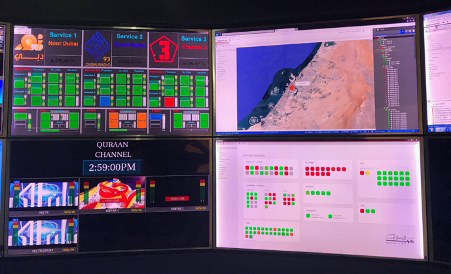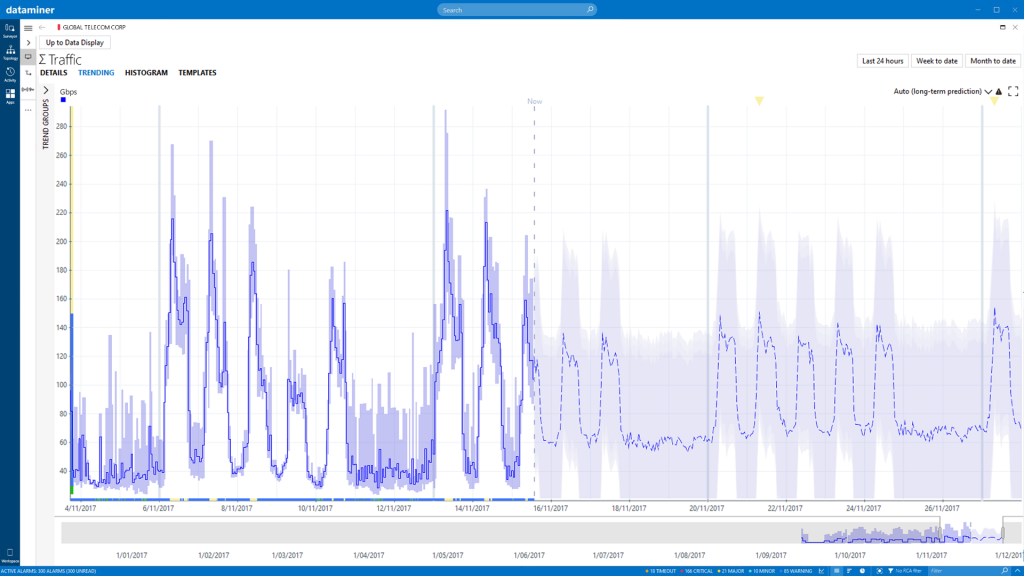OSS/BSS
Solutions for Operational Support teams (OSS/BSS)
Without doubt, today, OSS teams are in a battle to keep up current operations while being challenged to operate new services and underlying infrastructures.
First, a healthy and well-performing telecom network is of critical importance to digital businesses. In practice however, the level of agility and visibility offered by traditional monitoring tools or open source tools often fails to meet these business requirements.
Second, with the migration to IT and the introduction of cloud and containerized deployments, the new agile network architectures have a huge impact on the usefulness and performance of traditional network monitoring stacks.
Third, security operations are to be embedded in every single activity in the operations. Many traditional toolsets do not have the intelligence nor flexibility on board to achieve a secure operation.

Open NMS/OSS platform
The DataMiner NMS/OSS platform is an open platform with a vast set of capabilities readily on board. “Open” refers to the fact that the platform is fully documented. “Open” refers to our Dojo community of engineers, experts, system integrators, customers, fellow operators and consultants all collaborating to learn, share and get questions answered. “Open” also refers to the degree of customization DataMiner offers. Being a true DevOps environment, DataMiner-savy engineers have full control of how DataMiner looks like, how it behaves and how it interacts with other OSS/BSS systems, tools and databases.
Full-stack visibility and control for IT, media and broadband teams
DataMiner is built from the ground up to serve IT, media and broadband operations and technology. It is a best-in-class NMS, integrated with over 6000 APIs out of the bet, and new products and systems are added by the Skyline team, our system integrators and customers every day. Any video and media processing system, and broadband delivery component, any IT infrastructure, running on premises or in the cloud: DataMiner is guaranteed to implement the API.
Moreover, DataMiner has the relationship rules to correlate information across all layers of the deployment. Server to cluster to node to POD to container to media/broadband service. Media edge to IP flow to IP port to multicast path to destination. Is a media transcoder not functioning well because of a VM running short on memory? Is my broadband capacity underrunning because your EC2s fall short? DataMiner connects the dots for you. Between IT infra & deployments, media and broadband functions. For every team, so that everyone in the operations comes to the same conclusions and makes decisions in alignment rather that in contradiction. Consistency is key.
What about my existing OSS stack?
No worries. DataMiner is the glue, not necessarily the replacement of what you have deployed today. The same way DataMiner uses to connect to network elements and systems, DataMiner hooks up as easily to your OSS/ BSS systems and databases. So all of your configurations are preserved and your existing toolsets remain operational. DataMiner of course has access to all data and can easily make that visible to your teams on a single pane of glass. That is nice. Similarly, DataMiner can push new information into those systems, or even transfer information from one tool to the other.
Some typical use cases. DataMiner receives a ticket, can read the ticket details and, for example, execute a redundancy switch. Once that switch is executed successfully, DataMiner can update the ticket in your ticketing system. Or similarly, upon an incident, DataMiner can run some synthetic test on the network, attach the results to a brand-new ticket, and further enrich the ticket with any relevant information, historical and real time data. In milliseconds. Zero-touch (yeah, you know from experience that many operators need on average 20 minutes swivel-chairing and calling around to create a ticket that may not even be complete and accurate) .
Automation at your fingertips
Tired of using a plethora of scripting and automation tools by each domain or individual in your operation? Or simply lost the overview of all scripts and playbooks in use by someone, somewhere, sometimes, in some version or incarnation?
DataMiner has a built-in automation script editor, versioned script inventory manager, and run-time engine. DevOps is the way you use it: edit, have DataMiner verify the syntax and best practices for you (yes, DataMiner will carve out common mistakes done by your peers!), play. One CI/CD/CO pipeline. For all of your technical and operational workflows.
Activating automation can be triggered by all event types an operator can think of. Manually, scheduled, upon an API trigger, upon an alarm event, upon an incident, etc.
The upcoming DataMiner Process Automation (PA) puts an additional dimension on top of this. Building upon standard Business Process Modelling Notation (BPMN), you can design processes, and activate team during the time intervals you choose. An ever-growing catalog of off-the-shelf activities will be created by Skyline and the community that can be used to create your own processes. DataMiner will execute all of it, in a reliable and predictable manner. Why? Because DataMiner – like no other process automation system – can reserve human and technical resources to do the job. (ah yes, how many times did you come to the conclusion that a process failed because resources were not available or had no time?)
CI/CD … why not CO?
We’re all getting used to continuously integrate new systems and software images, roll them out and get going. Continuous Improvement and Continuous Deployment it is. For IT operators, this has always been the case. Media and broadband engineers come from a very different angle (products and systems in production rarely would change once installed, running the same software build for years!).
Now, CI/CD is nice, but... very often operations is running after the facts: how can one easily operate media and broadband services if the underlying system is continuously being redeployed and changing all the time? The simple answer is to add Continuous Operation (CO) into the equation. As DataMiner uploads new software images on the infrastructure, changes services and flows in the system, updates resource pools, etc., it is pretty straightforward for DataMiner to also update the operational environment fully in sync with data and control pipelines. As an example: if media or broadband services are changing, it is easy for DataMiner to also align your confidence monitoring probes to the new situation, update synthetic testing, reconfigure the NOC screens and multi-viewers, update the operator screens, and much more.
Collaboration is how we all (should) work
In this fast-moving world, operations teams not only need to connect to teams in their organization, but also beyond that. Connect with your customers, connect with your suppliers, connect with your peer operations teams in your industry (some still consider peers as competitors. Time to change your mindset, though).
DataMiner is a collaboration platform. Cloud connected. In real time. Would you like to get a new version of a protocol driver to match new firmware versions? The likelihood that you would find this in our cloud catalog is high. Would you like to share a DataMiner driver with the community? Easy to do. Would you like to share real-time and historical counters and metrics with your technology supplier? Just share a dashboard. You can also share a dashboard with your service performance and SLA status with your end customers. Or your content suppliers.

AIOps is here to stay
On the DataMiner price book, you will not find line items for AI algorithms. The reason is simple: we believe that AI is table stakes for any efficient operation. With DataMiner, AI is always there to assist in every aspect of the operation. Is it real (you know there’s a lot of smoke and mirrors out there -😉)? Yes, it is: trend forecasting, intelligent fault detection including detection of configuration and behavioural anomalies, but equally well proactive creation (proactive cap detection), or simply using focus alarms (those alarms DataMiner thinks you should have a look at with priority). Incident detection based on autonomous alarm grouping. Automated root cause analysis is coming up next, as well as suggestive dash boards, assisted data analytics and much more sweeties.
